-
Posts
200 -
Joined
-
Last visited
-
Days Won
5
Content Type
Profiles
Forums
Blogs
Gallery
Events
Store
Posts posted by Christian1962
-
-
1 hour ago, Simius Rex said:
That is not a small piece of ribbon! It is the right side of a Red Cross Ehrenzeichen ribbon!
The ÖKM.X ribbon is covering the left side of the Red Cross ribbon.
Yes, you are right. Same as EK12/13 is covering the JK1908.
Regards
Christian
1 hour ago, Simius Rex said:2 hours ago, Nicolas7507 said:The Tyrolian ribbon was a nonsense - sorry. It´s clear that it´s red cross WW1.
The problem is that the Schematismus is not very accurate. But there is missing too much. This is the reason why I am not happy with the match "Pfeffer".
It is possible that our guy did not serve in Bundesheer because he was dismissed in 1919/20 and called back to duty in 1938 as E-officer. He would have owned a 25-years service cross otherwise. So he would not be listed in any Schematismus. Hard to find.
It will remain an enigma....
Regards
Christian
1 -
4 hours ago, Nicolas7507 said:
Thank you very much for the info, Christian!
Any chances the decoration at the end is an öster. Ehrenzeichen für Verdienste um die Republik? Probably unlikely, as the bar is post-1938, I guess.
Best regards
Nicolas
Nicolas,
wearing of republican Austrian orders (note: Ehrenzeichen/Verdienstorden) was strictly forbidden in TR, just war medal 1914 - 18 and long service crosses could be worn.
I am not sure about red cross decorations but that´s not very relevant because the were extreme sparly awarded to Bundesheer officers.
If someone would have worn a republic order on his ribbon bar against regulars then he would not have done thos on last position. Thet would not make any sense.
The ribbon would not match and grade of the Ehrenzeichen/Verdienstorden. Rosettes were not in use. Italian Order of the Crown is the best and most plausible match. Germand red cross Ehrenzeichen would have had a miniature cross instead of a rosette.
The bar is post march 1938 - Wehrmacht and not Bundesheer style.
I could find a Militärzeugverwalter Johann Pfeffer who became Wehrmachtbeamter in 1938. He owned:
Silberne Militärverdienstmedaille am Bande des Militärverdienstkreuzes
Bronzene Militärverdienstmedaille.X
Goldenes Verdienstkreuz mit der Krone.X
Karl-Truppenkreuz
Ehrenzeichen 2. Kl. vom Roten Kreuz.KD
Österr. Kriegserinnerungsmedaille 1914-18.X
Jubiläumskreuz 1908
Ritterkreuz des ital. Kronenordens
ungar. Kriegsmedaille
This is the best match but not 100 %. There would be missing one TK-ribbon and a second sword device.
Regards
Christian
Thi
2 hours ago, Triad08 said:Hello. The 8th WIDE ribbon is an imperial Austrian Red Cross Honor Cross, not the Tirol Commemorative. This Red Cross ribbon has a very narrow Austrian War Commemorative ribbon wrapped around its left side. And considering the candidate has a wartime FJO-Knight, he was probably a military surgeon. This information about the candidate's medical background might help the search effort.
Last ribbon: Either the Italian Crown Order Officer's Cross or the Ehrenzeichen vom Roten Kreuz (Officer) of the Austrian First Republic is the last narrow ribbon wrapped around the right side of the Hungarian ribbon. I realize, the thin white margins are not present on the ribbon for the First Republic Red Cross award, but why would an Italian Crown Order Officer's Cross be mounted in the very last position? Regards.
Yes, an Italien Orden would have been on last position anyway. I would not bet my collection on a red cross ribbon.
My problem is this small piece of ribbon between ÖKM.X and JK1908:

I would think it´s the Tyrolian commemorative medal 1914-18. An Austrian red cross decoration from WW1 would be before ÖKM.X and not after. But the Tyrol medal makes no difference here because they were not listed in ÖBH-Schematismus.
Regards
Christian
2 hours ago, Triad08 said:0 -
My first impression would be:
EK2 1914
Franz Joseph-Orden Ritterkreuz mit KD
Militärverdienstkreuz 3. Kl. mit KD.X
Silberne Militärverdienstmedaille am Bande des MVK
Bronzene Militärverdienstmedaille am Bandes des MVK
Karl-Truppenkreuz
Kriegsmedaille
Österr. Kriegserinnerungsmedaille 1914-18.X
Tiroler Landesdenkmünze (small ribbon along ÖKM.X)
Jubiläumskreuz 1908
Erinnerungskreuz 1912/13
Ungarische Kriegserinnerungsmedaille
Offizierskreuz des italienischen Kronenordens
I will try to find out candidates for that combination.
The rarest decoration here would be the Italien Order of the Crown. I made a look through all recepients which are listed in ÖBH-Schematismus 1937, but no match at all. I am sure there were more awards after the print of this Schematismus in 1937. He could have received it during his Wehrmacht service too....
I fear it will be hard to give this bar a name.
Regards
Christian
1 -
2 hours ago, Valter said:
Great photo! It is post-1934, as I see Hindenburg cross after his combat awards and before peacetime decorations. What is the breast star with garter? Romanian?
It should be the grand officers breaststar of the Royal Bulgarian Order of Military Merit with war decoration.
Here a link: https://auctions.live-bidder.com/clients/rauch/en/sale/showLot/455/4410
Regards
Christian
1 -
Alexander Pappenheim is still listed as Oberlieutnant in Schematismus 1848. There was no Schematismus 1849. In Schematismus 1850 he is listed as "Erster Rittmeister" in DR 2. So we don´t know exactly when he was promoted to Rittmeister.
For me it sounds strange that he should have been portraied in 1847 as Rittmeister. I would assume that the stars were added later or that the pic is wrong dated?
I think that the cockades were not changed as quick and were worn ahead. This will not be a distinctive hint in my opinion.
Regards
Christian
0 -
Quite a very good peace too.?
I myself could purchase some parts of the Fattovich collection during the last years. Mostly collectors copies of rarest pieces. But their price increases very rapidly last year as you coul see last week at Rauch´s. That´s too much for copies.
Regards
Christian
0 -
I could find the link now:
https://alex.onb.ac.at/cgi-content/alex?aid=rgb&datum=1849&size=45&pos=246
Regards
Christian
0 -
FM Radetzky started in August 1848 introducing rank stars in his army. They were officially introduced with Reichsgesetzblatt 127/1848 and Erlass of Ministry of War dated with 14.02.1849 for all officers.
Rank stars for NCO were introduced with Entschließung from 30.08.1849.
Rank laces were introduced for Militär-Verpflegspersonal with 09.05.1848.
I hope this informations will be sufficient for you.
Regards
Christian
0 -
34 minutes ago, Elmar Lang said:
Zounds! That´s a really good one. Exeptional piece - my congratulations.
I just own a simply Lieutnant´s piece.
Regards
Christian
0 -
Good news!
I could find now the order of precedence effective with November 1917. It was published via "Erlass vom 15.11.1917, Präs. 31500":
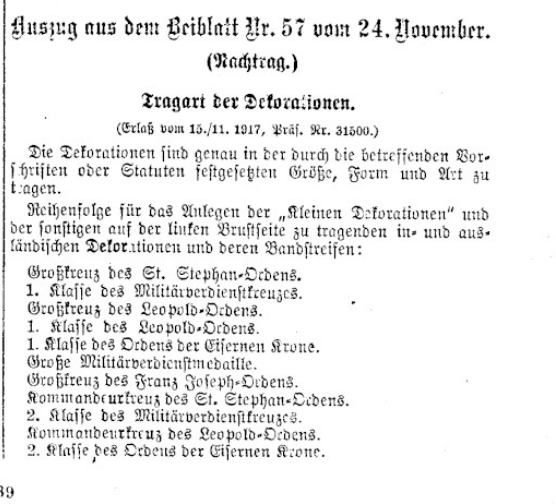

Here is the link: https://alex.onb.ac.at/cgi-content/alex?aid=stv&datum=1917&page=15066&size=45
Regards
Christian
1 -
I have tried to find out the correct precedence of k.u.k. orders with help of a friend who works in the Austrian State Archives. There was just a single sheet to find:
Another file would have been more interesting but it is missed. This special file was the reply of the Obersthofmeisteramt to Michetschläger when he asked for the precendence for his book.
BUT: so we can assume that he published the correct precedence in his book on base of this reply!
Regards
Christian
0 -
I have no evidence that ÖBH-Schematimen are oneline anwhere but I think I can help you researching in my own database. There are not so many officers with this combination of decorations as I assumed. Most of them had an EKO.3.X and/or an order of the Austrian Republic or the Prussian EK2. This narrows the candidates quite down:
Oberstleutnant Franz Reicher (IR 5)
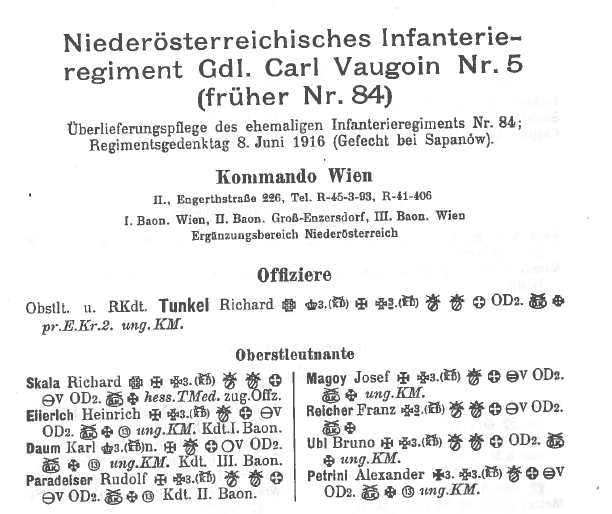
You must know that the Tyrolian War Medal 1914 - 1918 was not listed in Schematismus. And they were not very accurate with foreign medals such as the Hungarian war medal.
Reicher is the best match for active officers between 1928 (first printed Schematismus) and 1937 (last printed). It is evident that there could have been retired officers who never were listed in a Schematismus.
Regards
Christian
1 -
2 hours ago, Triad08 said:
Hello to Enzo. You are confident that the ribbon-bar under discussion features the Große Militärverdienstmedaille in the first position? There were a total of nineteen - 19 - KuK-officers who received this award, (not counting 9 Germans and 1 Turk). These officers were some of the most important and most renowned military leaders of the Empire. Are you suggesting that the OP, by some serendipitous coincidence, ended-up with a ribbon-bar belonging to one of the famous military personalities listed below? Regards.
Generaloberst Erzherzog Eugen
Linienschiffsleutnant Gottfried Banfield
Generaloberst Eduard Graf Paar
Generaloberst Arthur Freiherr von Bolfras
Generaloberst Karl Freiherr von Pflanzer-Baltin
Generaloberst Svetozar Boroevic von Bojna
Feldmarschall Erzherzog Friedrich
Generaloberst Franz Freiherr Conrad von Hötzendorf
Generaloberst Friedrich Freiherr von Georgi
Generaloberst Samuel von Hazai
Generaloberst Hermann Kövess von Kövessháza
Generaloberst Eduard von Böhm-Ermolli
Generaloberst Alexander Ritter von Krobatin
Generaloberst Erzherzog Joseph
General der Infanterie Arthur Freiherr Arz von Straussenburg
General der Infanterie Alfred Krauss
General der Kavallerie Alois Fürst Schönburg-Hartenstein
Feldmarschall Franz Freiherr Rohr von Denta
Oberstleutnant in Generalstab Hermann Pokorny
I have checked out now all owners of GMVM.X. No one of them owned a peacetime FJO of any grade.
That fact should rule out the variant with GMVM.X on that bar we are discussing.
But let´s make another experiment: let us assume the first ribbon stands for al GMVM.X which orders and medals could follow?
Variant 1:
GMVM.X
LO-KmtK.X
FJO-KmtK/St (peacetime) - which just was owned by FZM Tamásy (who held no GMVM.X)
FJO-KmtK.X
MVK.3.X
KM 1873
EK2
Variant 2:
GMVM.X
LO-KmtK.X
FJO-KmtK (peacetime) - which was not held by any GMVM-holder
FJO-O.X
MVK.3.X
Variant:
GMVM.X
LO-R.X
FJO-every grade (peacetime) - which was not held by any GMVM-holder
...
All following variants are not worth discussing them.
In my humble opinion that would rule out GMVM.X at this ribbon bar anyway. Therefore I would like to follow Triad´s argumentation.
At the other hand, if we look onto the variant MVK.2.X and LO-R.X we find:
Hugo Martiny
Hugo Edler von Habermann
Ernst Horsetzky von Hornthal
Ferdinand Kosak
Heinrich Goinger
Gustav Szekély de Doba
Gabriel Graf Marenzi
Viktor Bauer von Bauernthal
Karl von Stöhr
Franz Weiss-Tihany-Mainprugg
Karl Steiger
Eugen Edler von Luxardo
Ladislaus Jonik von Jamny
Julius Phleps
Josef Pacor von Karstenfels
Paul Hegedüs
Livius Borotha
Georg Ritter von Szypniewski
Viktor Edler von Kandler
Johann Schwalb
Dr. h.c. Eduard Fischer
Balthasar Pintar
Josef Freiherr von Janecka
Johann Haas von Haagenfels
Franz Graf Zedtwitz
Oskar Minnich
Heinrich Freiherr von Salis-Samaden
Ludwig Rath
Adolf Kornhaber von Pilis
Franz Edler von Haam
Alfred Edler von Hinke
Johann Ritter von Mossig
Rudolf Obauer von Bannerfeld
Walter Schreitter von Schwarzfeld
Ernest Edler von Terboglaw
Ferencz Biffl von Pilca
Now let´s have a look who out of this group owned a peacetime FJO-O/R:
Dr. h.c. Eduard Fischer
Paul Hegedüs
Josef Pacor von Karstenfels
Julius Phleps
Johann Schwalb
Walter Schreitter von Schwarzfeld
Gustav Szekély de Doba
Ernest Edler von Terboglaw
Franz Graf Zedtwitz
Now we exclude all who owned an EKO.3 because this is not on the bar, who will reach the next level:
Johann Schwalb
Walter Schreitter von Schwarzfeld
Ernest Edler von Terboglaw
And now we look who out the last three officers owned to more decorations with swords and in addition KM 1873 and EK2:
Ernest Edler von Terboglaw
Again in my humble opinion it´s a little bit more convincing.
We could now discuss another variant:
FJO-KmtK.X
LO-R.X
FJO-O/R (peacetime)
But there is not one officer from colonel upwards who held that combination. Maybe there are some few from lieutnant-colonel downwards, but I can´t check that now.
Regards
Christian
1 -
2 hours ago, Lukasz Gaszewski said:
It´s no question that GMVM ranked before LO-K and LO-R but this not the point regarding the ribbon bar above because Pokorny owned EKO3.KD(X?) and not FJO (peacetime). That rules him out as owner anyway.
Regards
Christian
0 -
I could find out one most likely candidate for that ribbon bar:
Generalmajor Ernst von Terboglaw.
He owned:
MVK 2.X, LO-R.X, FJO-O, MVK.3.X, BMVM.X, KM, EK2.
This would provide that he did not wear the full size peacetime FJO-O on his breast pocket but just on the ribbon bar. The combination of MVK2.X, LO-R.X and a peacetime FJO (R or O) appears to be a real rare case. But in addition with MVK.3.X and BMVM.X, KM and EK2 it could be a single case!
Here a potrait of him for comparison:
https://picryl.com/media/gmernst-edler-vterboglaw-bcdf8b
I could not find the variant FJO-K.X, LO-R.X, FJO (peacetime), MVK.3.X, BMVM.X, ... anyway.
You can check it out yourself there:
Steiner Jörg, Schematismus der Generale und Obersten der k.u.k. Armee - Stand 31.12.1918.
https://library.hungaricana.hu/en/view/Andere_Steiner_1992/?pg=0&layout=s
Regards
Christian
2 -
There was a given precedence for k.u.k. orders and medals, but sometimes it was not followed by the makers of ribbon bars. Your can see this precedence in the "Personalverordnungsblatt für das k.u.k. Heer" (see below) where all awards during WW1 were published.
They were ranked (following Michteschläger, see below):
.
.
.
Komturkreuz Leopold-Orden
Militärverdienstkreuz 2. Kl.
Orden der Eisernen Krone 2. Kl.
Ritterkreuz Leopold-Orden
Offizierskreuz Franz Joseph-Orden
Orden der Eisernen Krone 3. Kl.
Ritterkreuz Franz Joseph-Orden
Goldene Tapferkeitsmedaille für Offiziere
Silberne Tapferkeitsmedaille für Offiziere
Militärverdienstkreuz 3. Kl.
Silberne Militärverdienstmedaille am Bande des des Militärverdienstkreuzes
Bronzene Militärverdienstmedaille am Bande Militärverdienstkreuzes
..
.
Following this precedure the ribbon bar above should contain:
Militärverdienstkreuz 2. Kl.
Ritterkreuz Leopold-Orden
Ritterkreuz Franz Joseph-Orden (peacetime)
Militärverdienstkreuz 3. Kl. (most appearent, but could be Silberne MVM.X too)
Bronzene MVM.X
Kriegsmedaille
Eisernes Kreuz 2. Kl.
BUT: some weeks ago I could take a look on an estate of a k.u.k. Oberst and arty brigade commander. Here was the precedure different:
Komturkreuz Franz Joseph Orden with swords
Ritterkreuz Leopold-Orden
Orden der Eisernen Krone 3. Kl.
Militärverdienstkreuz 3. Kl.
SMVM.X
BMVM.X
Karl-Truppenkreuz
However, it is most likely that the above ribbon bar contains a commander Franz Joseph then a MVK 2. Kl. Otherwise in most cases there would be an Iron Crown 2. Cl. between them.
Anyway both combinations would be very rare.
Regards
Christian
1 -
It means "Kommandeur und Divisionskraftfahroffizier".
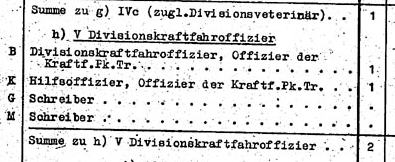
Regards
Christian
2 -
The crowns were not changed at the same date as Karl became emporer. It was done in October 1917.
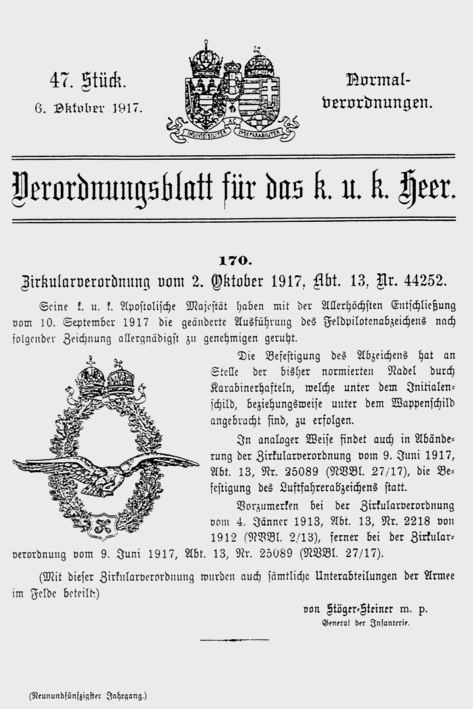
So should be pieces which displayed the single crown between approx. January/February 1917 and autumn 1917. Existing pieces were issued as long as on stock.
Regards
Christian
1 -
The national Coat o Arms was changed in 1915 from the single "Rudolph"-style crown to the double "Rudolph"-style and Hungarian Crown. Therefore you will find two versions of some medals during WW1. Compare with "Signum Laudis": here was the single crown in use until the death of emporer Franz Joseph. The medals of emporer Karl show the new type double crown.
Regards
Christian
0 -
Here you can see how the medal looks like if its stamped and not casted:
https://www.dorotheum.com/de/l/7149163/
Regards
Christian
0 -
Here are some more:
Generalmajor Arthur Zar:
28.03.1918 FJO-R+KD
24.08.1918 EKO 3+KD+X
Generalleutnant Rudolf Busich:
15.06.1916 FJO-R+KD+X
00.00.19__ EKO 3+KD
Generalmajor Kurt Hermann von Herrenalb:
05.03.1917 FJO-O+KD
24.03.1918 EKO 3+KD
Generalstabsarzt Dr. Franz Zhuber von Okrog:
22.02.1915 FJO-R+KD
04.02.1917 EKO 3+KD
Generalintendant Ludwig Eitel:
13.08.1915 FJO-R (it´s to assume with KD)
19.03.1918 EKO 3+KD
Generalintendant August Fratz:
11.05.1916 FJO-R+KD+X
02.12.1917 EKO 3+KD
Generalintendant Ludwig Kramberger:
23.12.1914 FJO-R+KD
07.02.1917 EKO 3+KD
Generalintendant Josef Lamatsch Edler von Waffenstein:
12.05.1915 FJO-R+KD+X
17.02.1916 FJO-O+KD+X
00.00.19__ EKO 3+KD+X
Generalintendant Ferdinand Lanzendörfer:
13.08.1915 FJO-R+KD
19.03.1918 EKO 3+KD
Generalintendant Heinrich Freiherr von Raabl-Werner:
13.08.1915 FJO-R (it´s to assume with KD)
16.03.1918 EKO 3+KD
00.00.1920 FJO-O+KD (nachträglich)
Generalintendant Anton Richter:
15.09.1915 FJO-R+KD+X
15.04.1920 EKO 3+KD+X (nachträglich)
Generalintendant Johann Schrböck:
22.02.1915 FJO-R+KD
18.12.1917 EKO 3+KD
Generaltintnendant Moritz Skutetzky:
06.06.1915 FJO-O+KD
26.02.1917 EKO 3+KD
Generalintendant Karl Urbauer:
10.07.1915 FJO-R+KD
20.06.1917 EKO 3+KD
I could just provide data for later Bundesheer-Generals, but you can see it was not as rare as people would think.
Regards
Christian
0 -
I can add some names:
Generalstabsarrzt Dr. Karl Brenner
12.02.1915 Ritterkreuz FJO+KD+X
05.05.1920 EKO 3+KD+X (nachträglich)
Generalstabsarzt Dr. Ernst Dub
Ritterkreuz FJO+KD
EKO 3+KD+X
Generalstabsarzt Dr. Josef Feix
04.04.1915 Ritterkreuz FJO+KD
00.00.1920 EKO 3+KD (nachträglich)
Generalstabsarzt DDr. Erhard Glaser
23.01.1915 EKO 3+KD
12.10.1915 Offizierskreuz FJO+KD
Generalstabsarzt Dr. Ignaz Hofer
07.04.1915 Ritterkreuz FJO-KD
00.00.1920 EKO 3+KD+X (nachträglich)
Generalstabsarzt Dr. Ignaz Kauder
22.02.1915 Ritterkreuz FJO+KD+X
00.00.1919 EKO 3 +KD+X (nachträglich)
Generalstabsarzt Dr. Adolf Knobel
09.03.1915 Ritterkreuz FJO+KD
23.05.1917 EKO 3+KD+X
Generalstabsarzt Dr. Jakob Lochbihler
24.12.1915 Offizierskreuz FJO-KD
15.12.1917 EKO 3+KD
Generalstabsarzt Dr. Emil Mattauchschek
18.03.1915 Ritterkreuz FJO+KD
00.00.19__ EKO 3+KD
Generalarzt z.V. Dr. Gottfried Nickl
11.03.1918 Rittekrreuz FJO+KD+X
00.00.19__ EKO 3+KD+X (nachträglich)
(out of a list of 70 Generalstabsärzte ÖBH)
etc., ect.
In general it´s to say: Order of Franz Joseph was bestowed for wartime service of medical officers, support and supply officers, Pioniere and Sappeure, Train etc. EKO 3+KD(+X) was awarded for frontline service under fire. But in some cases there was awarded EKO+KD(+X) as second decoration for the before mentioned group of officers.
It was more simple for me to extract my list of medical officers. But there were others too. Maybe I will have a second look tomorrow and can provide more names.....
There is a Train-officer:
Generalmajor Dr.h.c. Carl Graser
06.12.1917 Ritterkreuz FJO+KD
01.12.1920 EKO 3+KD (nachträglich)
Regards
Christian
0 -
5 hours ago, Utgardloki said:
Regarding the troop cross discussion. If you look into the "Verordnungsblatt für das k. u. k. Heer / Normalverordnungen / 25. Stück / 6. Juli 1918 S. 129ff"
you find the "Statuten und Durchführungsbestimmungen für das [...] Karl-Truppen-Kreuz"
https://alex.onb.ac.at/cgi-content/alex-day?aid=kkh&datum=19180706&seite=5&zoom=33
There you find on page 6 "Ad §3 Punkt 1."
"8. Anspruch auf das Karl-Truppenkreuz haben:"
and then under the letter n) (on page ?
"n) An Nazarener darf das Karl-Truppen-Kreuz nicht verliehen werden"
(That's the sentence the author of the OMSA-Text cites)
I am actually not sure if Jews are meant with this word - maybe one of you can help here
Beside that, I found the article "Das österreichische Karl-Truppen-Kreuz " in the "Orden und Ehrenzeichen" magazine number 51 from 2007 by Walter A. Schwarz. There he lists all the Verordnungsblätter regarding the cross. I couldn't find the ones like "BH Nr. 45/1917/Z. 639/S. 472" with the signature "BH" at the Austrian national library. What does "BH" mean?
Good morning!
You are right assuming that "Nazarener" are not jews but a christian sect/renewal movement as cited from Meyers Konversationslexikon.
The "BH"-signature should be from the official library of the Austrian ministery of defence. I will check that later and correct it when wrong.
A new point: please don´t forget the the k.u.k. army was very tolerant of many religious communities . So there existed an own corps of Jewish military rabbis (look at the pic below which is from "Schematismus für das k.u.k. Heer 1910, pg. 1235 and Rangliste 1918). During WW1 this corps was extended to 77 rabbis in 1918. Why should they have excluded Jews from the bestowing of the Karl-Troop-Cross...
Regards
Christian
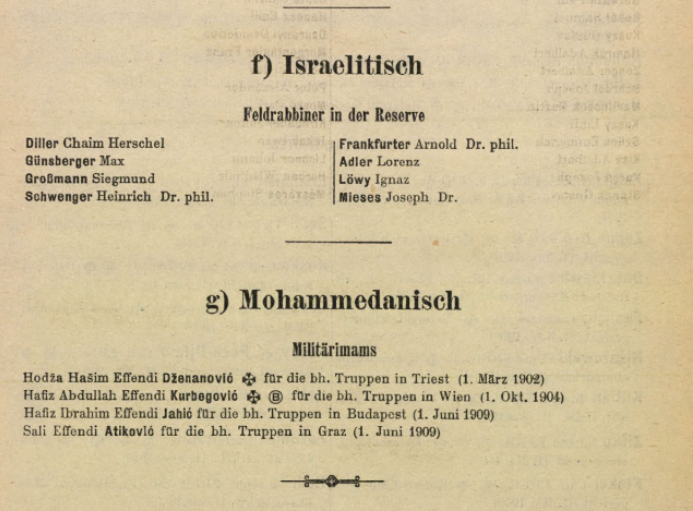
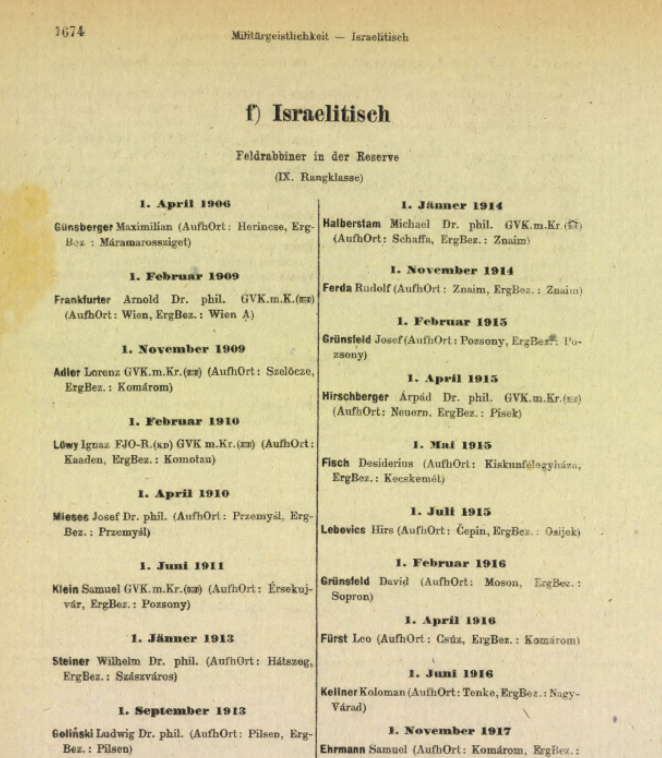 0
0 -
1 hour ago, graham said:
Christian,
Great info. Thanks.
Your are welcomed!
Regards
Christian
0



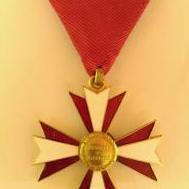

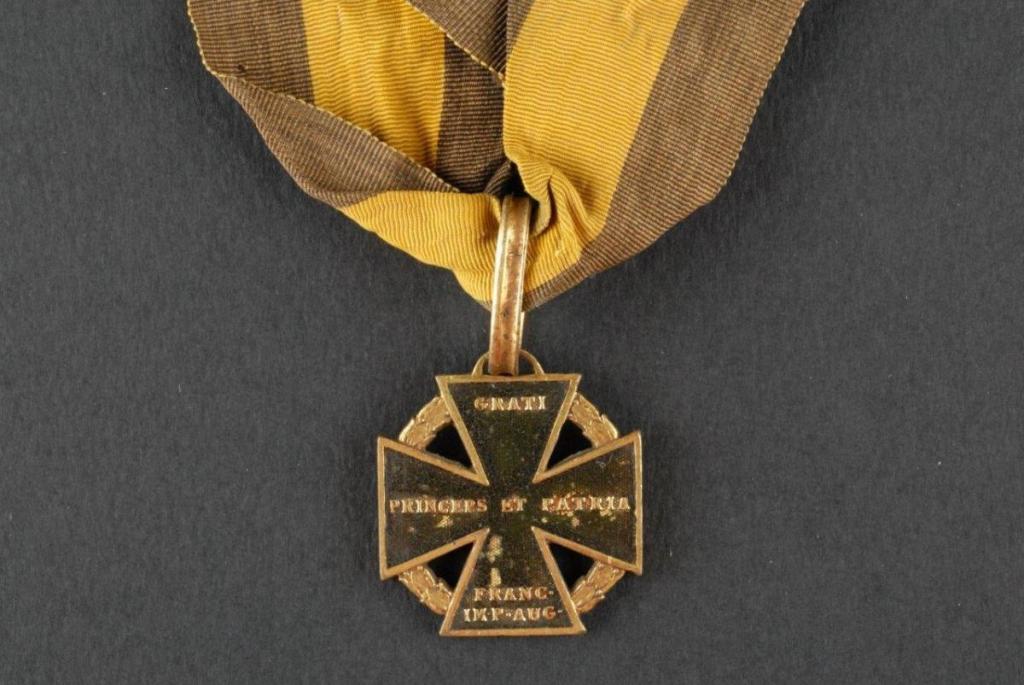
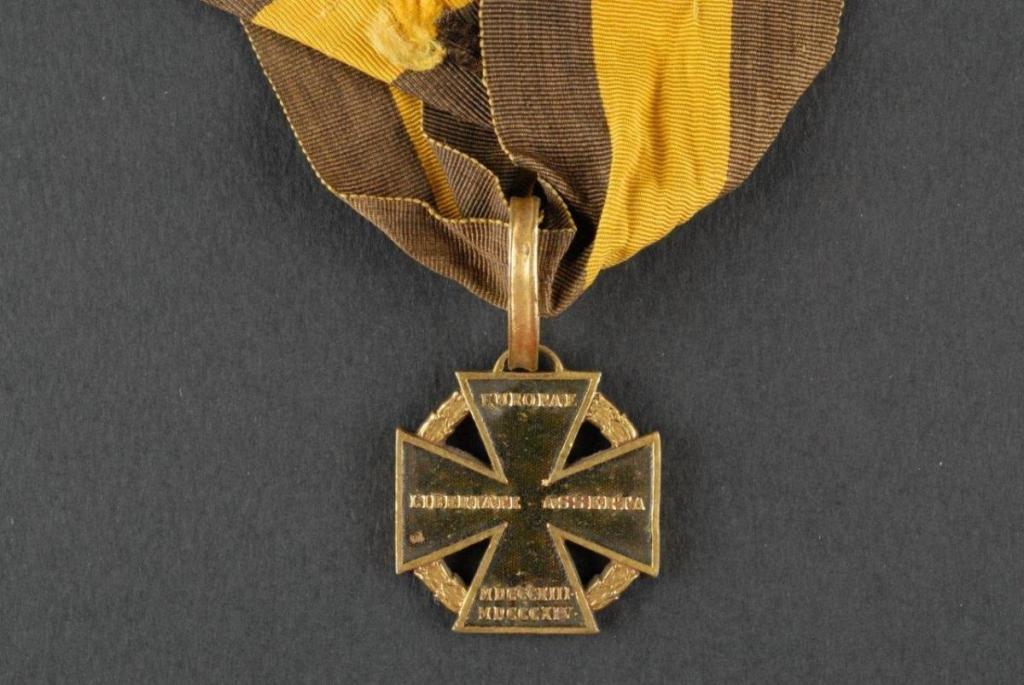
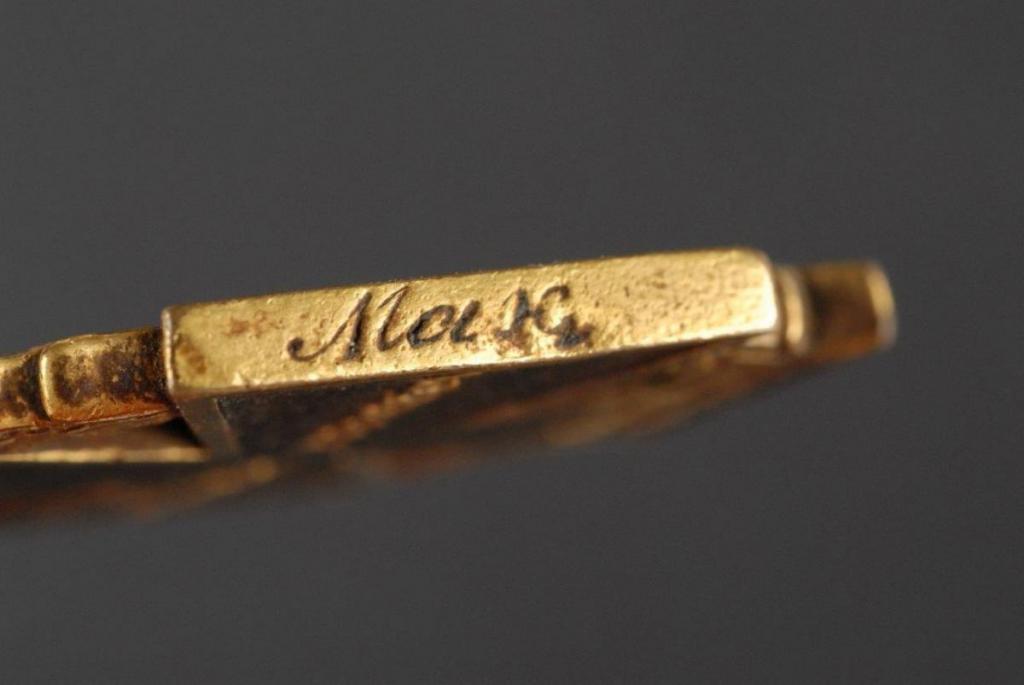
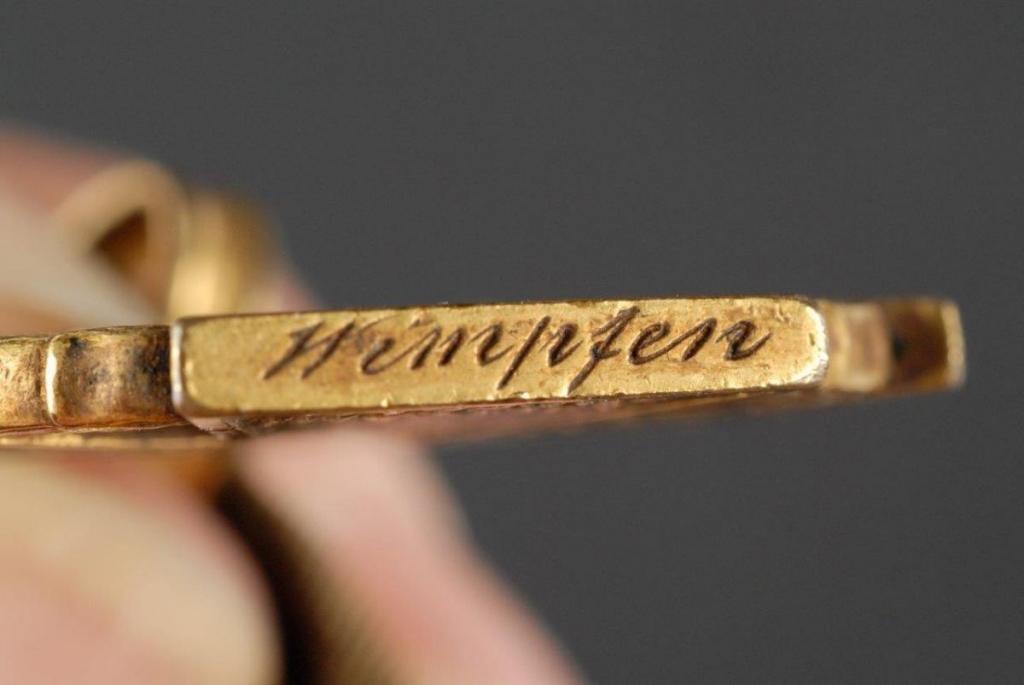
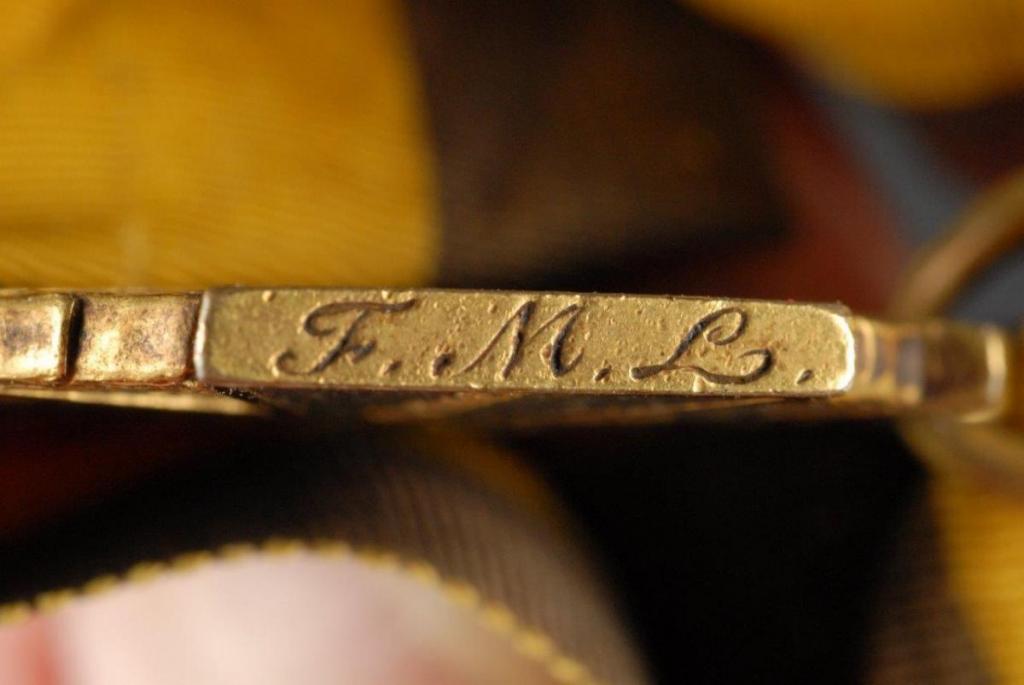
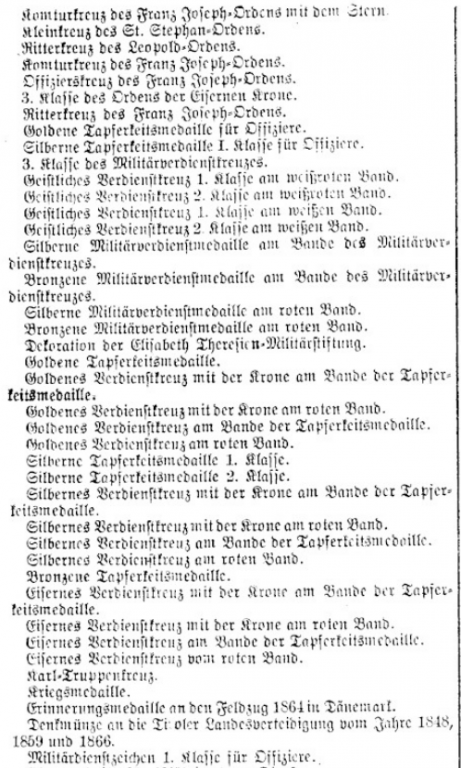

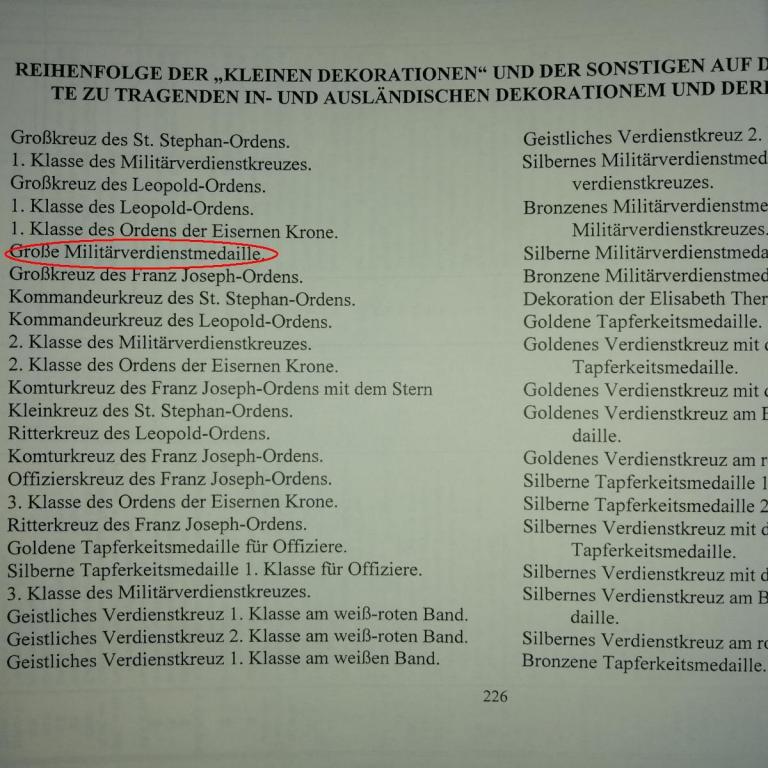
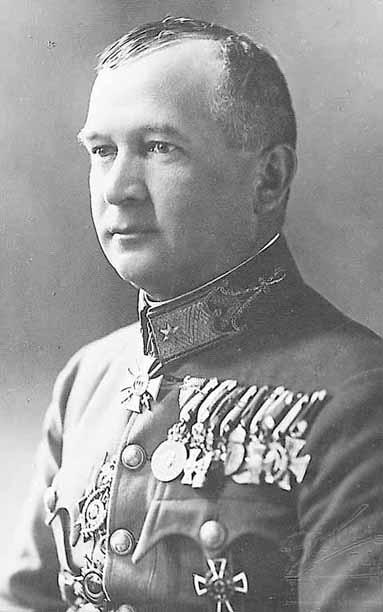
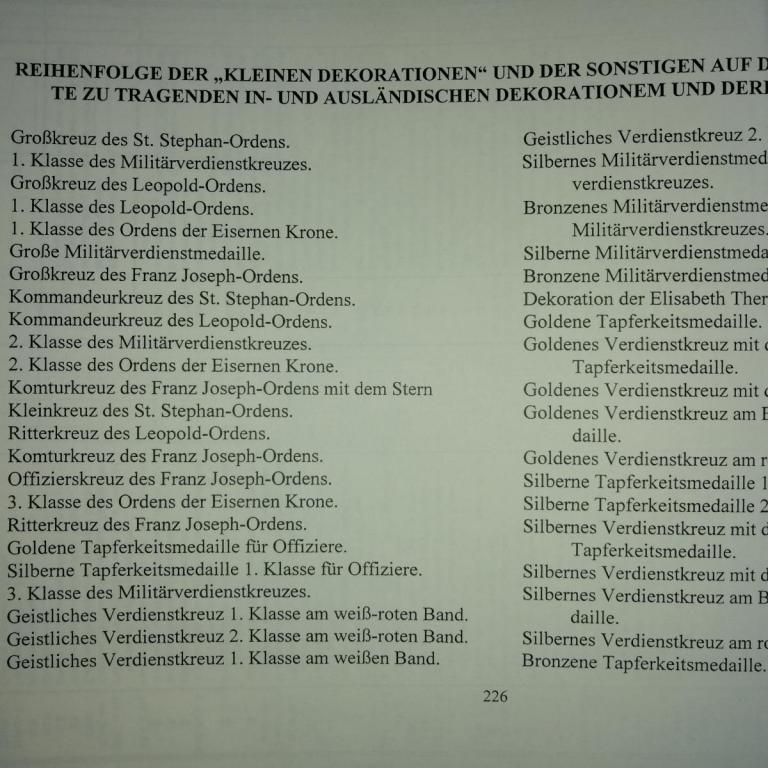
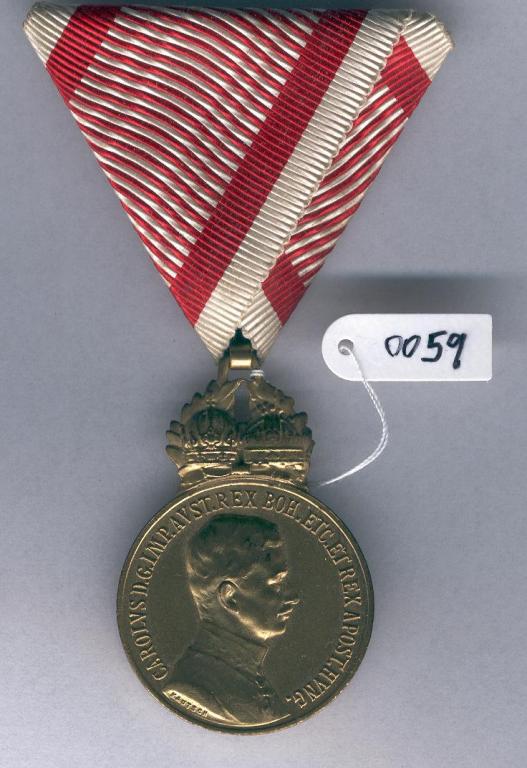
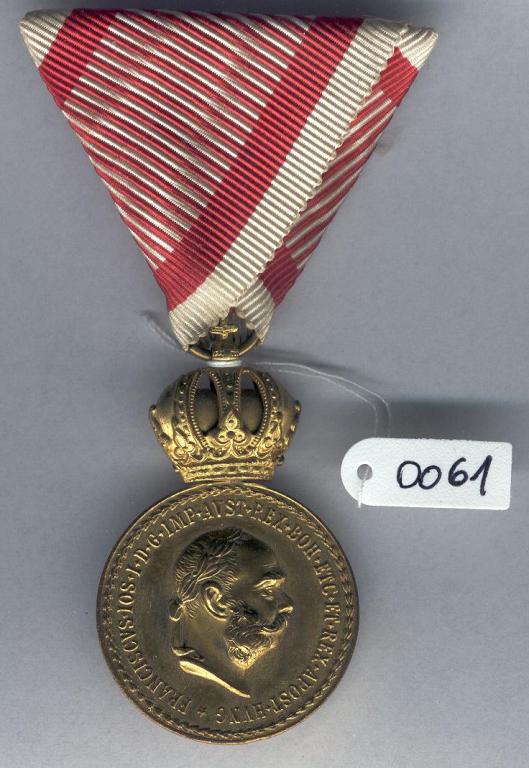
Austrian ribbon bar with golden bar and swords
in Austro-Hungarian Empire
Posted
You are welcomed, I always try to do my best, but not every effort leads to the goal.... ?♂️
Regards
Christian